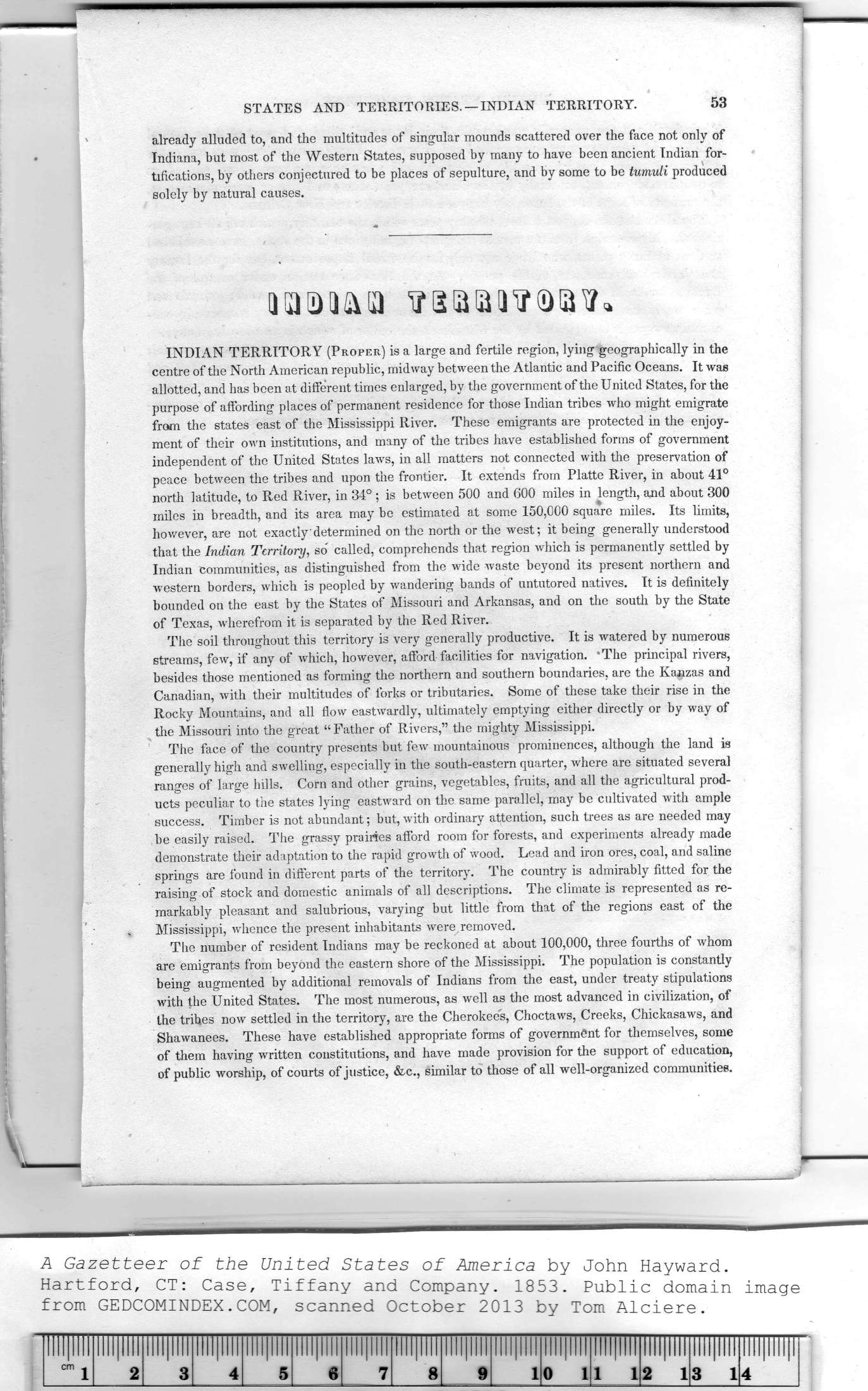|
|
Note: Ctrl and + increases the font size of the text below, Ctrl and - decreases it, and Ctrl and 0 resets it to default size.
STATES AND TERRITORIES. —INDIAN TERRITORY. 53
already alluded to, and the multitudes of singular mounds scattered over the face not only of
Indiana, but most of the Western States, supposed by many to have been ancient Indian for-
tifications, by others conjectured to be places of sepulture, and by some to be tumuli produced
solely by natural causes.
INDIAN TERRITORY (Proper) is a large and fertile region, lying geographically in the
centre of the North American republic, midway between the Atlantic and Pacific Oceans. It was
allotted, and has been at different times enlarged, by the government of the United States, for the
purpose of affording places of permanent residence for those Indian tribes who might emigrate
from the states east of the Mississippi River. These emigrants are protected in the enjoy-
ment of their own institutions, and many of the tribes have established forms of government
independent of the United States laws, in all matters not connected with the preservation of
peace between the tribes and upon the frontier. It extends from Platte River, in about 41°
north latitude, to Red River, in 34° ; is between 500 and 600 miles in length, and about 300
miles in breadth, and its area may be estimated at some 150,000 square miles. Its limits,
however, are not exactly determined on the north or the west; it being generally understood
that the Indian Territory, so called, comprehends that region which is permanently settled by
Indian communities, as distinguished from the wide waste beyond its present northern and
western borders, which is peopled by wandering bands of untutored natives. It is definitely
bounded on the east by the States of Missouri and Arkansas, and on the south by the State
of Texas, wherefrom it is separated by the Red River.
The soil throughout this territory is very generally productive. It is -watered by numerous
streams, few, if any of which, however, afford facilities for navigation. ‘The principal rivers,
besides those mentioned as forming the northern and southern boundaries, are the Kanzas and
Canadian, with their multitudes of forks or tributaries. Some of these take their rise in the
Rocky Mountains, and all flow eastwardly, ultimately emptying either directly or by way of
the Missouri into the great “ Father of Rivers," the mighty Mississippi.
The face of the country presents but few' mountainous prominences, although the land is
generally high and swelling, especially in the south-eastern quarter, where are situated several
ranges of large hills. Corn and other grains, vegetables, fruits, and all the agricultural prod-
ucts peculiar to the states lying eastward on the same parallel, may be cultivated with ample
success. Timber is not abundant; but, w'ith ordinary attention, such trees as are needed may
be easily raised. The grassy prairies afford room for forests, and experiments already made
demonstrate their adaptation to the rapid growth of wood. Lead and iron ores, coal, and saline
springs are found in different parts of the territory. The country is admirably fitted for the
raising of stock and domestic animals of all descriptions. The climate is represented as re-
markably pleasant and salubrious, varying but little from that of the regions east of the
Mississippi, whence the present inhabitants were removed.
The number of resident Indians may be reckoned at about 100,000, three fourths of whom
are emigrants from beyond the eastern shore of the Mississippi. The population is constantly
being augmented by additional removals of Indians from the east, under treaty stipulations
with the United States. The most numerous, as well as the most advanced in civilization, of
the tribes now settled in the territory, are the Cherokees, Choctaws, Creeks, Chickasaws, and
Shawanees. These have established appropriate forms of government for themselves, some
of them having written constitutions, and have made provision for the support of education,
of public worship, of courts of justice, &c., similar to those of all well-organized communities.
|
lllllllll |
llll|llll|llli|llll |
lllllllll |
lllllllll |
|
|
lllllllll |
lllllllll |
lllllllll |
lllllllll |
lllllllll |
lllllllll |
lllllllll |
|
|
cm j |
2 j 3 |
4 |
5 |
6 |
7 |
8 |
9 |
1 |
0 1 |
1 1 |
2 1 |
3 1 |
4 |
|
